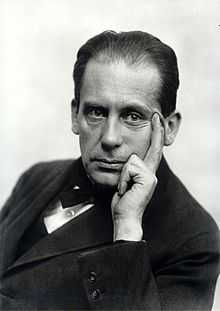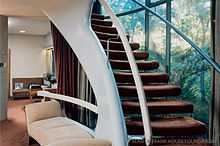Walter Gropius
| Walter Gropius | |
|---|---|
 Walter Gropius (circa 1919). Photo by Louis Held | |
| Born |
Walter Adolph Georg Gropius May 18, 1883 Berlin, German Empire |
| Died |
July 5, 1969 (aged 86) Cambridge, Massachusetts, United States |
| Nationality | German/American |
| Awards |
AIA Gold Medal (1959) Goethe Prize (1961) |
| Practice |
Peter Behrens (1908–1910) |
| Buildings |
Fagus Factory |
Walter Adolph Georg Gropius (May 18, 1883 – July 5, 1969) was a German architect and founder of the Bauhaus School,[1] who, along with Ludwig Mies van der Rohe, Le Corbusier and Frank Lloyd Wright, is widely regarded as one of the pioneering masters of modern architecture.
Early life
Born in Berlin, Walter Gropius was the third child of Walter Adolph Gropius and Manon Auguste Pauline Scharnweber.
Gropius married Alma Mahler (1879–1964), widow of Gustav Mahler. Walter and Alma's daughter, named Manon after Walter's mother, was born in 1916. When Manon died of polio at age 18, composer Alban Berg wrote his Violin Concerto in memory of her (it is inscribed "to the memory of an angel"). Gropius and Alma divorced in 1920. (Alma had by that time established a relationship with Franz Werfel, whom she later married).
Early career (1908–1914)
Walter Gropius, like his father and his great-uncle Martin Gropius before him, became an architect. Gropius could not draw, and was dependent on collaborators and partner-interpreters throughout his career. In school he hired an assistant to complete his homework for him. In 1908 Gropius found employment with the firm of Peter Behrens, one of the first members of the utilitarian school. His fellow employees at this time included Ludwig Mies van der Rohe, Le Corbusier, and Dietrich Marcks.
In 1910 Gropius left the firm of Behrens and together with fellow employee Adolf Meyer established a practice in Berlin. Together they share credit for one of the seminal modernist buildings created during this period: the Faguswerk in Alfeld-an-der-Leine, Germany, a shoe last factory. Although Gropius and Meyer only designed the facade, the glass curtain walls of this building demonstrated both the modernist principle that form reflects function and Gropius's concern with providing healthful conditions for the working class. Other works of this early period include the office and factory building for the Werkbund Exhibition (1914) in Cologne.
In 1913, Gropius published an article about "The Development of Industrial Buildings," which included about a dozen photographs of factories and grain elevators in North America. A very influential text, this article had a strong influence on other European modernists, including Le Corbusier and Erich Mendelsohn, both of whom reprinted Gropius's grain elevator pictures between 1920 and 1930.[2]
Gropius's career was interrupted by the outbreak of World War I in 1914. Called up immediately as a reservist, Gropius served as a sergeant major at the Western front during the war years, and was wounded and almost killed.[3]
Bauhaus period (1919–1932)


Gropius's career advanced in the postwar period. Henry van de Velde, the master of the Grand-Ducal Saxon School of Arts and Crafts in Weimar was asked to step down in 1915 due to his Belgian nationality. His recommendation for Gropius to succeed him led eventually to Gropius's appointment as master of the school in 1919. It was this academy which Gropius transformed into the world famous Bauhaus, attracting a faculty that included Paul Klee, Johannes Itten, Josef Albers, Herbert Bayer, László Moholy-Nagy, Otto Bartning and Wassily Kandinsky. One example product of the Bauhaus was the armchair F 51, designed for the Bauhaus's directors room in 1920 – nowadays a re-edition in the market, manufactured by the German company TECTA/Lauenfoerde.
In 1919, Gropius was involved in the Glass Chain utopian expressionist correspondence under the pseudonym "Mass." Usually more notable for his functionalist approach, the "Monument to the March Dead," designed in 1919 and executed in 1920, indicates that expressionism was an influence on him at that time.
In 1923, Gropius designed his famous door handles, now considered an icon of 20th-century design and often listed as one of the most influential designs to emerge from Bauhaus. He also designed large-scale housing projects in Berlin, Karlsruhe and Dessau in 1926–32 that were major contributions to the New Objectivity movement, including a contribution to the Siemensstadt project in Berlin.
Post Bauhaus (1933–1945)

With the help of the English architect Maxwell Fry, Gropius was able to leave Nazi Germany in 1934, on the pretext of making a temporary visit to Italy for a film propaganda festival, he then fled to Britain to avoid the fascist powers of Europe . He lived and worked in Britain, as part of the Isokon group with Fry and others and then, in 1937, moved on to the United States. The house he built for himself in Lincoln, Massachusetts, (now known as Gropius House) was influential in bringing International Modernism to the U.S. but Gropius disliked the term: "I made it a point to absorb into my own conception those features of the New England architectural tradition that I found still alive and adequate."[4]

Gropius and his Bauhaus protégé Marcel Breuer both moved to Cambridge, Massachusetts to teach at the Harvard Graduate School of Design and collaborate on projects including The Alan I W Frank House in Pittsburgh and the company-town Aluminum City Terrace project in New Kensington, Pennsylvania, before their professional split. In 1944, he became a naturalized citizen of the United States.
In 1945, Gropius founded The Architects' Collaborative (TAC) based in Cambridge with a group of younger architects. The original partners included Norman C. Fletcher, Jean B. Fletcher, John C. Harkness, Sarah P. Harkness, Robert S. MacMillan, Louis A. MacMillen, and Benjamin C. Thompson. TAC would become one of the most well-known and respected architectural firms in the world. TAC went bankrupt in 1995.
In 1967, Gropius was elected into the National Academy of Design as an Associate member, and became a full Academician in 1968.
Death
Gropius died in 1969 in Boston, Massachusetts, aged 86.
Legacy
Today, Gropius is remembered not only by his various buildings but also by the district of Gropiusstadt in Berlin. In the early 1990s, a series of books entitled The Walter Gropius Archive was published covering his entire architectural career. The CD audiobook Bauhaus Reviewed 1919–33 includes a lengthy English Language interview with Gropius.
Upon his death his widow, Ise Gropius, arranged to have his collection of papers divided into early and late papers. Both parts were photographed with funds provided by the Thyssen Foundation. The late papers, relating to Gropius' career after 1937, and the photos of the early ones, then went to the Houghton Library at Harvard University; the early papers and photos of the late papers went to the Bauhaus Archiv, then in Darmstadt, since reestablished in Berlin.[5]
In 1959 he received the AIA Gold Medal.
Selected buildings


- 1910–1911 the Fagus Factory, Alfeld an der Leine, Germany
- 1914 Office and Factory Buildings at the Werkbund Exhibition, 1914, Cologne, Germany
- 1921 Sommerfeld House, Berlin, Germany designed for Adolf Sommerfeld
- 1922 competition entry for the Chicago Tribune Tower competition
- 1925–1932 Bauhaus School and Faculty, Housin, Dessau, Germany
- 1936 Village College, Impington, Cambridge, England
- 1936 66 Old Church Street, Chelsea, London, England
- 1937 The Gropius House, Lincoln, Massachusetts, USA
- 1939 Waldenmark, Wrightstown Township, Pennsylvania (with Marcel Breuer)
- 1942–1944 Aluminum City Terrace housing project, New Kensington, Pennsylvania, USA
- 1949–1950 Harvard Graduate Center, Cambridge, Massachusetts, USA (The Architects' Collaborative)[6]
- 1945–1959 Michael Reese Hospital, Chicago, Illinois, USA – Master planned 37-acre (150,000 m2) site and led the design for at least 8 of the approx. 28 buildings.[citation needed]
- 1957–1960 University of Baghdad, Baghdad, Iraq
- 1963–1966 John F. Kennedy Federal Office Building, Boston, Massachusetts, USA
- 1948 Peter Thacher Junior High School,
- 1957–1959 Dr. and Mrs. Carl Murchison House, Provincetown, Massachusetts, USA (The Architects' Collaborative)
- 1958–1963 Pan Am Building (now the Metlife Building), New York, with Pietro Belluschi and project architects Emery Roth & Sons
- 1957 Interbau Apartment blocks, Hansaviertel, Berlin, Germany, with The Architects' Collaborative and Wils Ebert
- 1960 Temple Oheb Shalom (Baltimore, Maryland)
- 1960 the Gropiusstadt building complex, Berlin, Germany
- 1961 The award-winning Wayland High School, Wayland, Massachusetts, USA (demolished 2012)
- 1959–1961 Embassy of the United States, Athens, Greece (The Architects' Collaborative and consulting architect Pericles A. Sakellarios)
- 1968 Glass Cathedral, Thomas Glassworks, Amberg
- 1967–1969 Tower East, Shaker Heights, Ohio, this was Gropius' last major project.
- 1973-1980 Porto Carras, at Chalkidiki, Greece, was built posthumously from Gropius designs, it is one of the largest holiday resorts in Europe.
The building in Niederkirchnerstraße, Berlin, known as the Gropius-Haus is named for Gropius' great-uncle, Martin Gropius, and is not associated with Bauhaus.
References
- ↑ Bauhaus, The Tate Collection, retrieved 2008-05-18
- ↑ American Colossus: the Grain Elevator 1843–1943, Colossus Books, 2009. american-colossus.com
- ↑ "Walter Adolph Gropius 1883 – 1969". British Broadcasting Corporation. Retrieved 2006-08-02.
- ↑ Gropius House by Walter Gropius
- ↑ "Gropius, Walter, 1883–1969. Additional papers". Houghton Library, Harvard University, Online Finding Aid. Retrieved June 4, 2012.
- ↑ Harvard Graduate Center – Walter Gropius – Great Buildings Online
Further reading
- The New Architecture and the Bauhaus, Walter Gropius, 1935.
- The Scope of Total Architecture, Walter Gropius, 1956.
- From Bauhaus to Our House, Tom Wolfe, 1981.
- The Walter Gropius Archive, Routledge (publisher), 1990–1991.
External links
| Wikiquote has a collection of quotations related to: Walter Gropius |
| Wikimedia Commons has media related to Walter Gropius. |
- Designer portrait on rosenthalusa.com
- More information on Gropius's early years at the Bauhaus can be found in his correspondence with Lily Hildebrandt, with whom he had an affair between 1919–22: Getty Research Institute, California.
- Bauhaus Reviewed 1919–33 audiobook liner notes at LTM
|